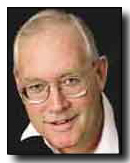Getting Away With Hate Crimes
- IAN HUNTER
What these Visigoths did was to vandalize and desecrate a holy place.
 |
|
Ian Hunter
|
International Womens Day was observed in Montreal last week by a handful of protesters storming a Roman Catholic cathedral. On a pillar outside Mary Queen of the World Cathedral, protesters spray painted: ReligionA Trap for Fools. Inside, they disrupted those who had come to worship by spray-painting slogans on the altar, turning over flowerpots, sticking sanitary padssome soiledto pictures and walls and throwing condoms around the cathedral sanctuary, said the National Post. A nun who was present said: They came in yelling things against religion. They said they were claiming the right to abortion and freedom of speech.
The classic formulation used to be that freedom of speech did not include the right to yell Fire! in a crowded theatre; apparently it will now be argued that freedom of speech includes the right to disrupt prayer in churches. And, incidentally, when did vandalism become speech?
Father Jean-Pierre Couturier, the vicar, said hymn books were ripped and two altar cloths taken. Seven people, four women and three men, were arrested and charged with unlawful assembly.
The first, understandable, reaction is outrage.
No doubt these protesters did not represent women who wanted to celebrate International Womens Day in Montreal, still less the women of Canada; any more than Marc Lepine, who brutally gunned down women engineering students, represented the men of Montreal, still less all Canadian men. But what happened at Mary Queen of the World Cathedral was a despicable act that, in its hatred of religion, revealed a satanic streak not far below the surface of militant feminism.
Those allegedly responsible for the cathedral outrages committed at least five criminal offences: disrupting a clergyman in the performance of his duties (s. 176); interrupting persons assembled for religious worship (s. 176 (2)); nuisance (s. 180); mischief to property (s. 430); and theft (s. 322). Yet they were not charged with these offences, but rather with unlawful assembly (s. 63). This offence is defined in the code as an assembly of three or more persons who, with intent to carry out a common purpose, cause others in the neighbourhood to fear, on reasonable grounds, that they will disturb the peace tumultuously.
Unlawful assembly is an offence shot through with difficulties of proof. It fairly invites Charter defences. Why would the police lay the charge of unlawful assembly when there appears to be convincing evidence of at least five other, more serious, criminal offences having been committed? Could it be because unlawful assembly, a summary conviction offence, carries the least penalty?
A police spokesman said hate crime charges were not being contemplated because the elements were not there for charges of that kind.
The hate crime sections (principally s. 319) make it an offence to communicate statements in a public place inciting hatred against an identifiable group. Are Christians generally, or Roman Catholics specifically, not an identifiable group? This argument is foreclosed by s. 318 (4), which defines identifiable group as any section of the public distinguished by ... religion.
So, why no hate crime charges? Well, the police spokesman referred to the statutory exemption: in good faith, attempting to establish by argument an opinion on a religious subject, (s. 319 (3)(b)).
Just a minute. How does spray painting slogans, sticking up sanitary pads, overturning flowerpots, ripping hymn books and stealing altar cloths, become an argument about religion?
What these Visigoths did was to vandalize and desecrate a holy place. If that has become freedom of speech, or argument on a religious subject, then night has become day, and Alice has triumphed again. H
ad this been a mosque or a synagogue desecrated, every possibly applicable charge in the Criminal Code would have been laid against the perpetrators. But it was a Christian church and, among the chattering classes, anti-Christian bigotry is de rigueur.
There is one reaction to all this that is not understandableat least not rationallyand that is the one that the Church will exemplify, forgiveness. Why? Because even greater indignities were heaped upon Him whom the Church glorifies, and His response was Father, forgive them, for they know not what they do.
 This is Meaghen Gonzalez, Editor of CERC. I hope you appreciated this piece. We curate these articles especially for believers like you.
This is Meaghen Gonzalez, Editor of CERC. I hope you appreciated this piece. We curate these articles especially for believers like you.
Please show your appreciation by making a $3 donation. CERC is entirely reader supported.

Acknowledgement
Hunter, Ian. Getting away with hate crimes. The National Post (March 14, 2000).
Reprinted with permission of The National Post.
The Author
Ian Hunter holds degrees in political science (B.A.) and law (L.L.B and J.D.) from the University of Toronto. From 1974 to 1996 he was a Professor of Law at Western University: he also taught at other Canadian and English Universities, and was a Visiting Scholar at Wolfson College, Cambridge. At Western University, Professor Hunter was awarded the University's Gold Medal for Teaching Excellence. He is the author of several books, including a bestselling biography of Malcolm Muggeridge Malcolm Muggeridge: A Life. He is a frequent columnist in the Globe and Mail and the National Post.
Copyright © 2000 National Post



